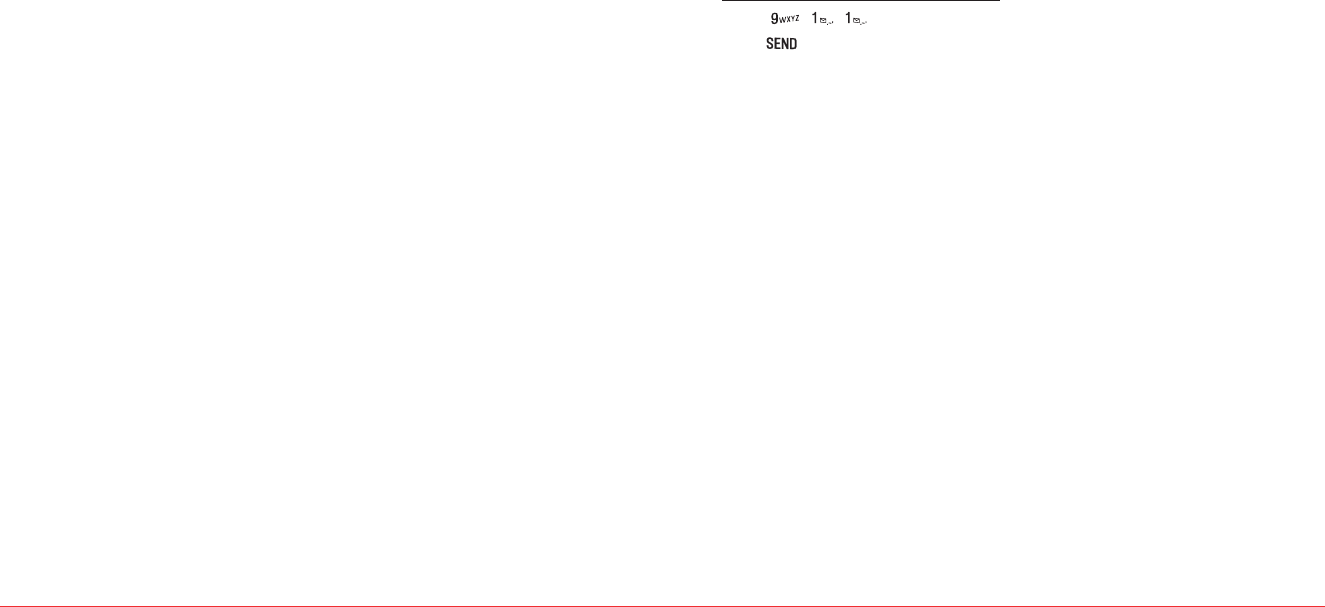
Appendix 69
To call “911” in “Phone Lock” or “Restrict” mode
1. Enter
,
,
.
2. Press
. “911” and “Emergency” will appear
on the screen.
H�
COMPLIANCE WITH OTHER FCC
REGULATIONS
OPERATING PROCEDURES
Never violate any of the following Rules and
Regulations of the FCC when using your Cellular
Phone. Such violations are punishable by fine,
imprisonment or both.
•
Never use your Cellular Phone to send false
distress calls.
•
Never wiretap or otherwise intercept a phone
call, unless you have first obtained the consent
of the parties participating in the call.
•
Never make any anonymous calls to annoy,
harass, or molest other people.
•
Never charge another account without
authorization, to avoid payment for service.
•
Never willfully or maliciously interfere with any
other radio communications.
•
Never refuse to yield the line when informed
that it is needed for an Emergency Call. Also,
never take over a line by stating falsely that it
is needed for an emergency.
H�
GENERAL SAFETY
PRECAUTIONS
Your Handheld Portable Telephone is a high
quality piece of equipment. Before operating, read
all instructions and cautionary markings on the
product, battery and adapter/charger.
Failure to follow the directions below could result
in serious bodily injury and/or property damage
due to battery liquid leakage, fire or rupture.
•
DO NOT use or store this equipment in a place
where it will be exposed to high temperatures,
such as near an open flame or heat-emitting
equipment.
•
DO NOT drop your device or subject it to severe
shock. When not using, lay down the unit to
avoid possible damage due to instability.
•
DO NOT expose this equipment to rain or
spilled beverages.
•
DO NOT use unauthorized accessories.
•
DO NOT disassemble the phone or its accesso-
ries. If service or repair is required, return to an
authorized UTStarcom cellular service center.
If unit is disassembled, the risk of electric shock
or fire may result.
H�
ANTENNA
ANTENNA SAFETY
Use only the supplied or an approved replacement
antenna. Unauthorized antennas, modifications, or
attachments could impair call quality, damage the
68 Appendix
H�
EMERGENCY CALLS
Never rely solely upon your wireless phone for
essential communications (e.g., medical emergen
-
cies), if it can be avoided, since a wireless phone
requires a complex combination of radio signals,
relay stations and landline networks for its
operation. Consequently, emergency calls may not
always be possible under all conditions on all wire
-
less phone systems. Your wireless phone, however,
may sometimes be the only available means of
communication at the scene of an accident. When
making an emergency call, always give the recipi
-
ent all necessary information as accurately as pos
-
sible. Never terminate an emergency call until you
have received clearance to do so.
FCC ENHANCED 911 (E911) RULES
Background
The Federal Communications Commission (FCC)
requires wireless carriers to transmit specific lati
-
tude and longitude location (Automatic Location
Identification = ALI) information as well as “911”
calls to Public Safety Answering Points (PSAPs)
to identify the location of the caller in case of
emergency.
Generally, the rules require that carriers identify
an E911 caller’s location within 50 meters of the
actual location for 67 percent of calls and within
150 meters of the actual location for 95 percent
of calls.
UTStarcom CDM8964VM ALI Capability.
The UTStarcom CDM8964VM is an ALI-capable
phone equipped with a GPS (Global Positioning
System) receiver supporting a satellite-based GPS
ALI-capable network to comply with the FCC’s ALI
requirements.
The network compliance with the above FCC
requirements is dependent on: (a) the use of
digital technology by the wireless network; (b)
GPS satellite signals being able to reach the phone
(such transmissions do not always work indoors,
for example) ; and (c) phone signals reaching
wireless “base stations” (atmospheric and environ
-
mental conditions may cause variations in phone
receiving signal strength).
Also the transmission of the ALI information is
subject, in part, to system constraints within the
wireless network to which the E911 signal is trans
-
mitted and over which UTStarcom has no control.
Finally, customers are advised that the UTStarcom
CDM8964VM ALI capability is to be used for E911
purposes only.
This feature allows you to place an emergency call
even if your phone is in “Phone Lock” or “Restrict”
mode when you dial the preprogrammed emer
-
gency number, 911, #911, or *911. It also operates
in out-of-service areas.
The phone maintains emergency mode until you
press after disconnecting an emergency call. In
emergency call mode, the phone can receive an
incoming call from any available system.
080814_CDM8964_IM_EN.indd 68-69 2008.8.14 2:25:3 PM


















